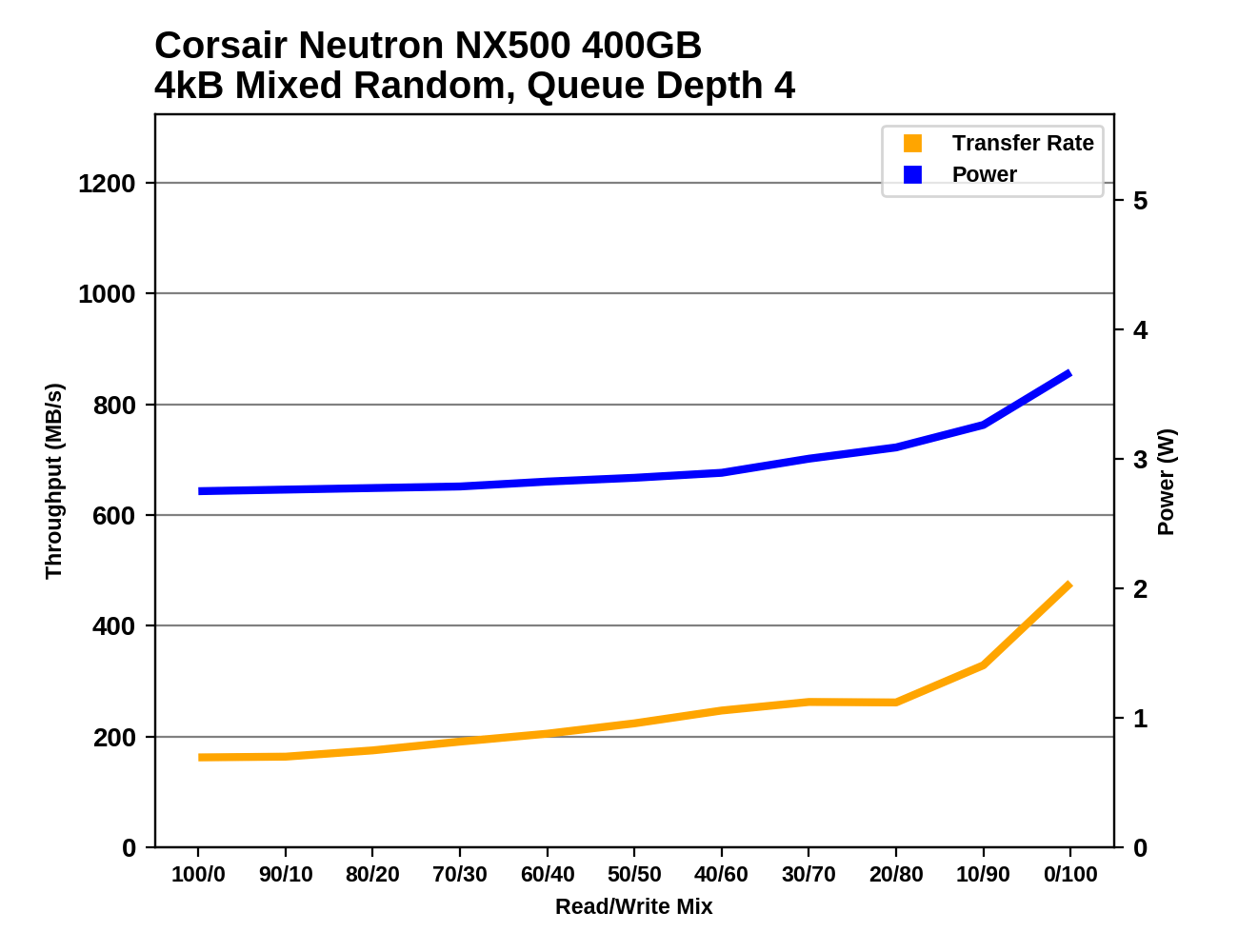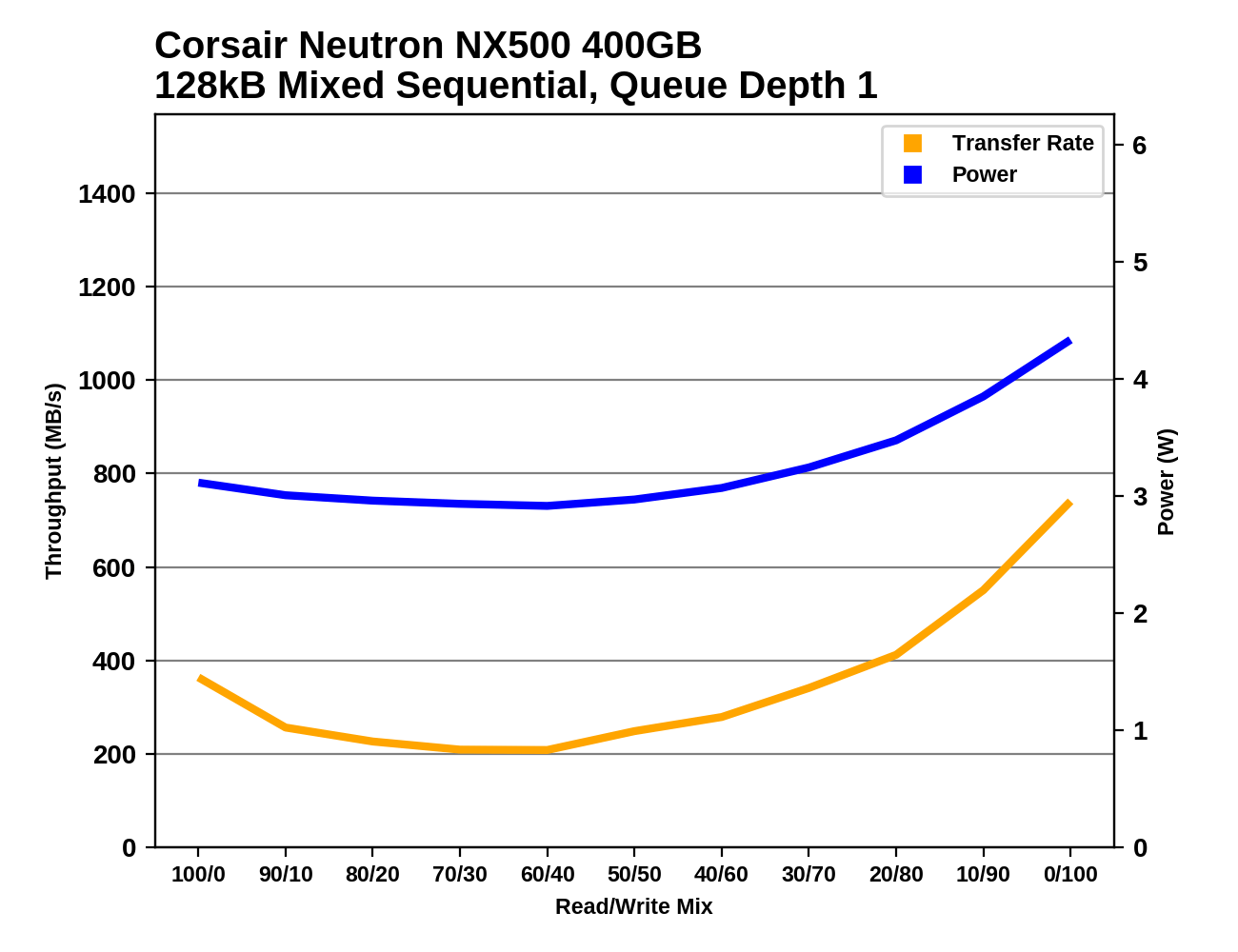The Corsair Neutron NX500 (400GB) PCIe SSD Review: Big Card, Big Pricetag
by Billy Tallis on August 16, 2017 10:00 AM ESTMixed Random Performance
Our test of mixed random reads and writes covers mixes varying from pure reads to pure writes at 10% increments. Each mix is tested for up to 1 minute or 32GB of data transferred. The test is conducted with a queue depth of 4, and is limited to a 64GB span of the drive. In between each mix, the drive is given idle time of up to one minute so that the overall duty cycle is 50%.

The QD4 mixed random I/O performance of the Corsair Neutron NX500 is pretty good overall, but the Patriot Hellfire has a clear advantage. The Zotac SONIX on the other hand can't beat the SATA-based Samsung 850 PRO and is only slightly faster than the Intel 600p.

The power efficiency of the NX500 during the mixed random I/O test is about average, while the faster Patriot Hellfire beating all the other planar NAND SSDs in this bunch.
 |
|||||||||
The performance of the Neutron NX500 increases gradually as the portion of writes increases, not dropping anywhere along the way but also not spiking very high in the final phase of the test where many drives improve greatly.
Mixed Sequential Performance
Our test of mixed sequential reads and writes differs from the mixed random I/O test by performing 128kB sequential accesses rather than 4kB accesses at random locations, and the sequential test is conducted at queue depth 1. The range of mixes tested is the same, and the timing and limits on data transfers are also the same as above.

The mixed sequential performance of the Corsair Neutron NX500 is poor, with it and the Patriot Hellfire performing slightly worse than the SATA-based Samsung 850 PRO and only beating the entry-level TLC NVMe drives. The Zotac SONIX on the other hand performed quite well, though still a bit slower than what the OCZ RD400A manages using the same NAND.

The power efficiency of the NX500 and Patriot Hellfire rank no better than their overall performance on the mixed sequential test, and the Zotac SONIX is only modestly better off.
 |
|||||||||
The NX500's performance on the mixed sequential test bottoms out with 70/30 and 60/40 read/write mixtures, but then shows good improvement as the proportion of writes continues to increase. Most of the MLC drives are able to avoid the performance drop that the NX500 suffers in the early phases of this test, which is what leads to the Zotac SONIX scoring so much better than the NX500.










45 Comments
View All Comments
damianrobertjones - Thursday, August 17, 2017 - link
Opens Amazon/ebay and types 'Toshiba XG5'. Nothing found. Oh well you've lost a possible sale Toshiba! Well done. (U.K.)mapesdhs - Thursday, August 17, 2017 - link
Get a 960 Pro instead, far better buy. My 512GB was only 249 UKP new.Or if you want to save some pennies, look for an SM951, SM961 or the older 950 Pro.
Billy Tallis - Thursday, August 17, 2017 - link
The XG5 is an OEM drive. They're selling every single one they can manufacture to companies like Dell. We'll see a retail counterpart eventually, once their BiCS3 manufacturing volume ramps up.wazoo42 - Thursday, August 17, 2017 - link
What happened to the performance consistency tests? Those were one of the primary reasons I went to Anand for SSD reviews.Billy Tallis - Thursday, August 17, 2017 - link
They'll be back eventually. I'm currently keeping the testbed busy around the clock with all the new drives that have arrived recently, plus re-testing older drives on the new 2017 test suite. The steady-state performance consistency test was the least realistic benchmark on the old 2015 test suite, so its replacement in the 2017 suite is my lowest priority. Once the testbed has some idle time, I'll go back and run the steady-state performance consistency tests on everything.In the meantime, the ATSB tests do have consistency scores in the form of 99th percentile latency, including broken down by reads and writes. I'm also considering adding some form of consistency score to the synthetic benchmarks that are already in this review.